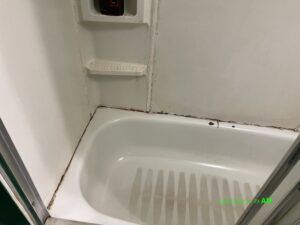bathroom mold removal
How Do I Get Rid of Bathroom Mold? Your Bathroom Mold Removal Guide

Bathroom mold isn’t something anyone is ever happy to see, but it is common. The bathroom is the ideal breeding ground for mold; it’s damp, warm, and a relatively small space. If you don’t sufficiently air out a bathroom with an extractor fan or by opening a window, that warmth and moisture can cause mold.
The most common areas to find mold in the bathroom is on caulk, grouting, and painted surfaces since it provides a porous surface for the mold to hold onto. Since you’re here, we can safely assume you have found mold in your bathroom, and you want to know how to get rid of it.
The good news is it’s straightforward to remove mold. Read on to learn how to clean the mold in your bathroom and prevent it from happening again.
Can I remove bathroom mold by myself?
Small amounts of mold that grow on caulk, grout, and painted bathroom surfaces can be removed during your normal bathroom cleaning. We’ll guide you through how to remove minor appearances of mold below, but if you discover a larger patch that has been developing for some time, it’s best to contact a Bathroom mold remediation company to remove it for you. Mold can be harmful to your health, especially when disturbed, so do not try to tackle anything that looks like it has been in place for some time.
How do I get rid of mold on grout?
If you’ve noticed some dark spots appearing on your grout, it’s likely little specks of mold. While sealed tile is mold-resistant, grout is not unless it is sealed regularly. If there’s just a little mold and your grout is white, you can use a simple bleach or white (distilled) vinegar solution to spray and rub away the mold. If it does not simply wipe away, you can leave it to sit for up to 30 minutes and use a small brush to scrub it away.
If you have colored grout, it’s best to speak to bathroom mold removal specialists as using bleach, vinegar, or baking soda may make the color fade, and so it’s best to seek specialist advice.
How do I remove bathroom mold from a painted wall?
If mold has grown on painted or wallpapered surfaces in your bathroom, you’ll need to be careful. You cannot use bleach, but some lightly diluted white (distilled) vinegar can be effective. Simply spray or wipe some of the solution over the mold and it should come away easily.
If your bathroom has been decorated with bathroom paint, this will be easier, but matt paint and luxury wallpapers can prove more of a challenge. If you’re not sure, a bathroom mold removal company can advise you.
How do I prevent bathroom mold?
- Use your bathroom extractor fan or open a window as you shower, or immediately after if it’s too cold
- If you have a shower curtain, pull it out straight (so it’s not bunched up) after showering so it can dry efficiently
- Make sure towels are hung up and can dry properly
- Wash towels, mats, and your shower curtain regularly
- Make sure your faucets don’t have a leak (even a constant drip can make the room more humid)
- Reseal your grout once a year
- Repair/replace caulking that’s no longer effective
- Paint over walls that have normal paint with special bathroom or kitchen paint, as it’s designed to be water and mold resistant
General Tips for your Bathroom
Proper ventilation in bathrooms is vital to lowering humidity. Besides piping systems behind the walls in the bathroom, showering and general sink use creates elevated humidity which can be a breeding ground for mold and create a mold condition. Extraction fans should be installed in bathrooms, you typically need a one-inch fan for every 100 sq. ft of bathroom space. Backsplashes and tubs should be recaulked and regrouted every 18 months regardless of the deterioration of the sealant of backsplashes. Building materials used for bathrooms should exclusively be cement board, tile, and grout. Ultimately, framing of the bathroom should be used with metal studs not wood 2 x 4’s. Once a leak has been identified, and sheetrock has been affected by water damage in a bathroom, it should be immediately replaced. Once sheetrock has been affected by water damage, as it dries, it becomes more porous. Porous building materials are a breeding ground for mold growth.
A mold inspection and testing are recommended when you are not sure if you have mold, especially if you can’t see it. It may be in your bathroom behind a wall, inside the ceiling, or in an area that you can’t get to or see, you should contact a mold professional to help you.
CLICK HERE for a Bathroom Mold Inspection
Bathroom Mold Removal in New York
If you’ve found mold in your bathroom and it’s unsafe to handle alone or is in a difficult-to-reach area, we’re here to help. We’re mold remediation specialists in New York and will remove bathroom mold safely from your home or place of work, ensuring the health of everyone inhabiting the building. To find out more, click here.
How Do I Get Rid of Bathroom Mold? Your Bathroom Mold Removal Guide Click To Tweet

Recent Comments